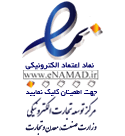Search published articles
Showing 3 results for Bazzazi
H Bazzazi, M.a. Ramezani, M Bazoori, A Mohamadi Bondarkheili, M Arabahmadi, A Ghaemi,
Volume 1, Issue 1 (Spring - Summer 2007 [PERSIAN] 2007)
Volume 1, Issue 1 (Spring - Summer 2007 [PERSIAN] 2007)
Abstract
Bazzazi, H., Govahi, M., Jahazi, A., Alizadeh, Sh., Naeimi Tabiee, E, Mokaram, R., Davarpanah, M R,
Volume 6, Issue 2 (Autumn- Winter [PERSIAN] 2012)
Volume 6, Issue 2 (Autumn- Winter [PERSIAN] 2012)
Abstract
Hadi Bazzazi, Yaghoub Yazdani, Nasser Behnampour, Hadi Hossein-Nataj, Ali Memarian, Mehrdad Aghaei,
Volume 13, Issue 6 (Nov-Dec 2019)
Volume 13, Issue 6 (Nov-Dec 2019)
Abstract
| Page 1 from 1 |

This work is licensed under a Creative Commons Attribution-NonCommercial 4.0 International License.



